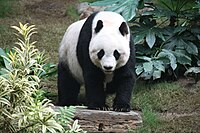
Photo from wikipedia
Inbreeding can have negative consequences on population and individual fitness, which could be counteracted by inbreeding avoidance mechanisms. However, the inbreeding risk and inbreeding avoidance mechanisms in endangered species are… Click to show full abstract
Inbreeding can have negative consequences on population and individual fitness, which could be counteracted by inbreeding avoidance mechanisms. However, the inbreeding risk and inbreeding avoidance mechanisms in endangered species are less studied. The giant panda, a solitary and threatened species, lives in many small populations and suffers from habitat fragmentation, which may aggravate the risk of inbreeding. Here, we performed long‐term observations of reproductive behaviour, sampling of mother–cub pairs and large‐scale genetic analyses on wild giant pandas. Moderate levels of inbreeding were found in 21.1% of mating pairs, 9.1% of parent pairs and 7.7% of panda cubs, but no high‐level inbreeding occurred. More significant levels of inbreeding may be avoided passively by female‐biased natal dispersal rather than by breeding dispersal or active relatedness‐based mate choice mechanisms. The level of inbreeding in giant pandas is greater than expected for a solitary mammal and thus warrants concern for potential inbreeding depression, particularly in small populations isolated by continuing habitat fragmentation, which will reduce female dispersal and increase the risk of inbreeding.
Journal Title: Molecular Ecology
Year Published: 2017
Link to full text (if available)
Share on Social Media: Sign Up to like & get
recommendations!